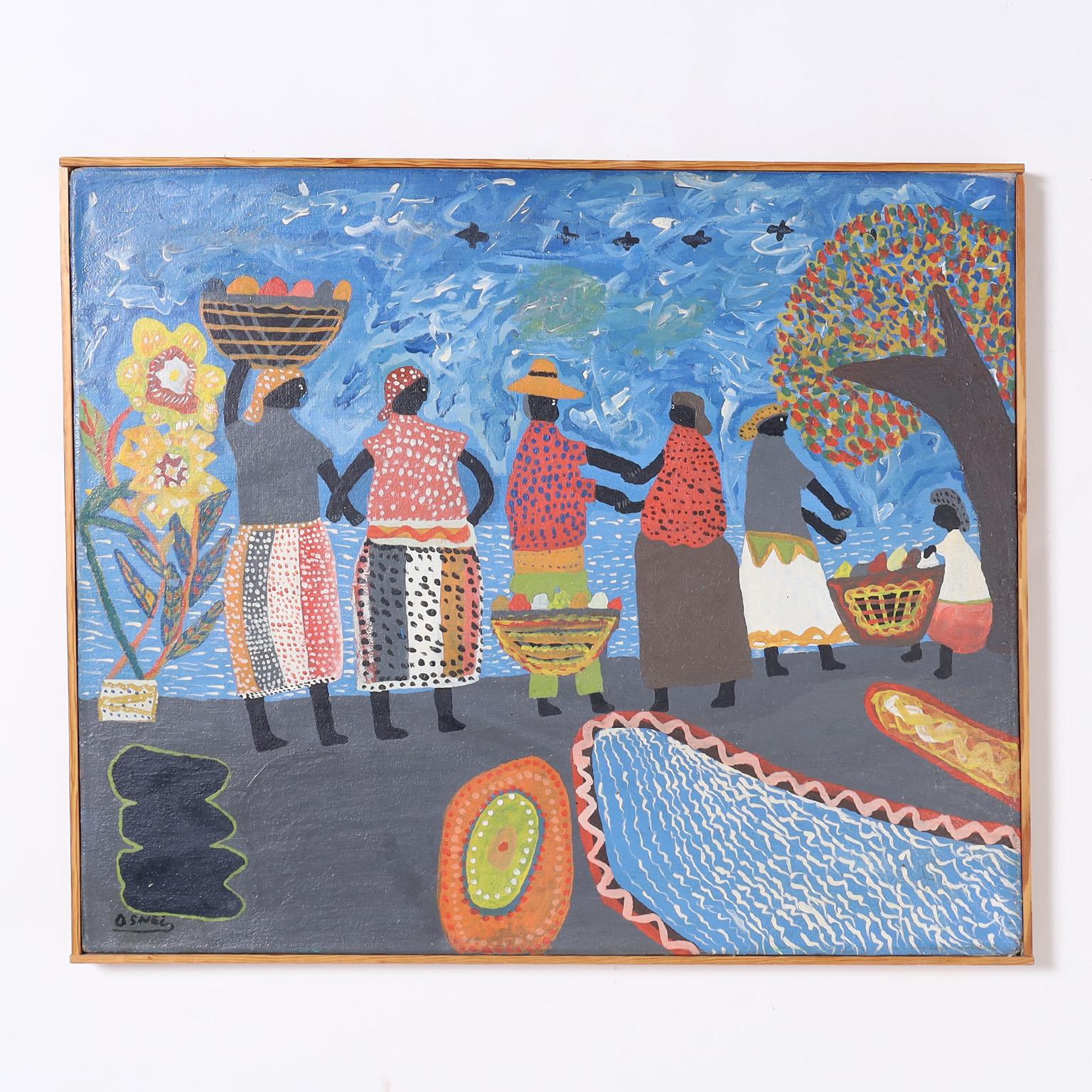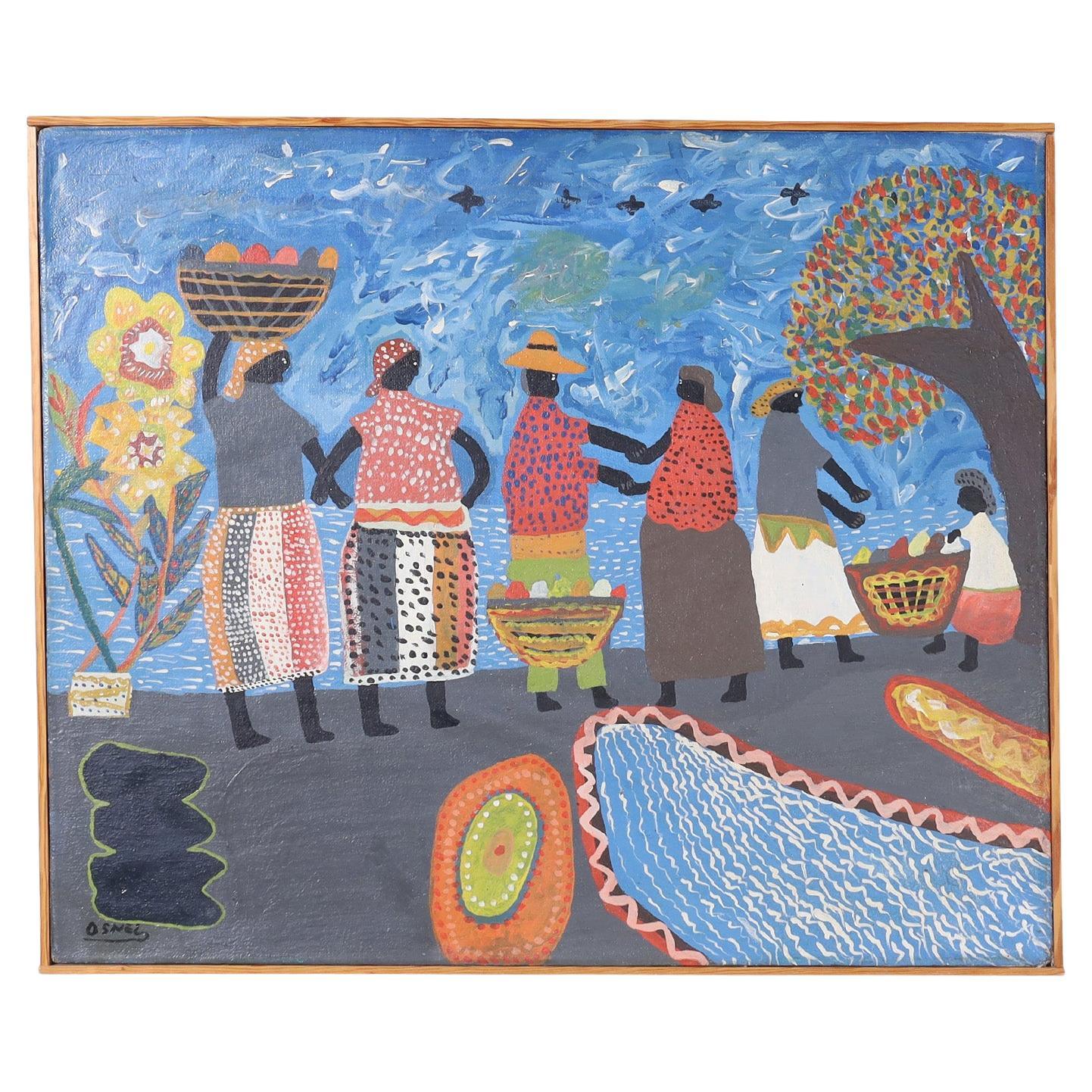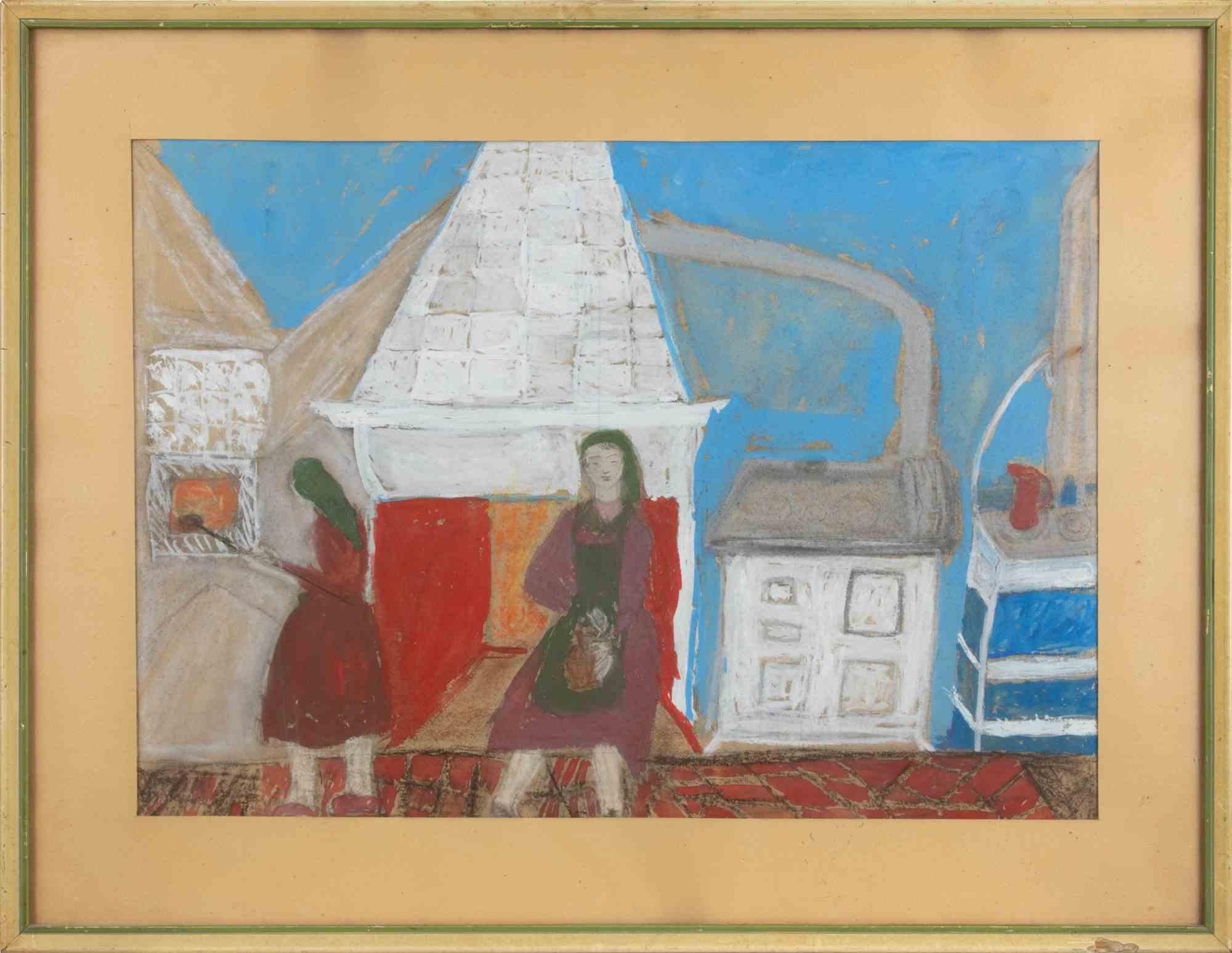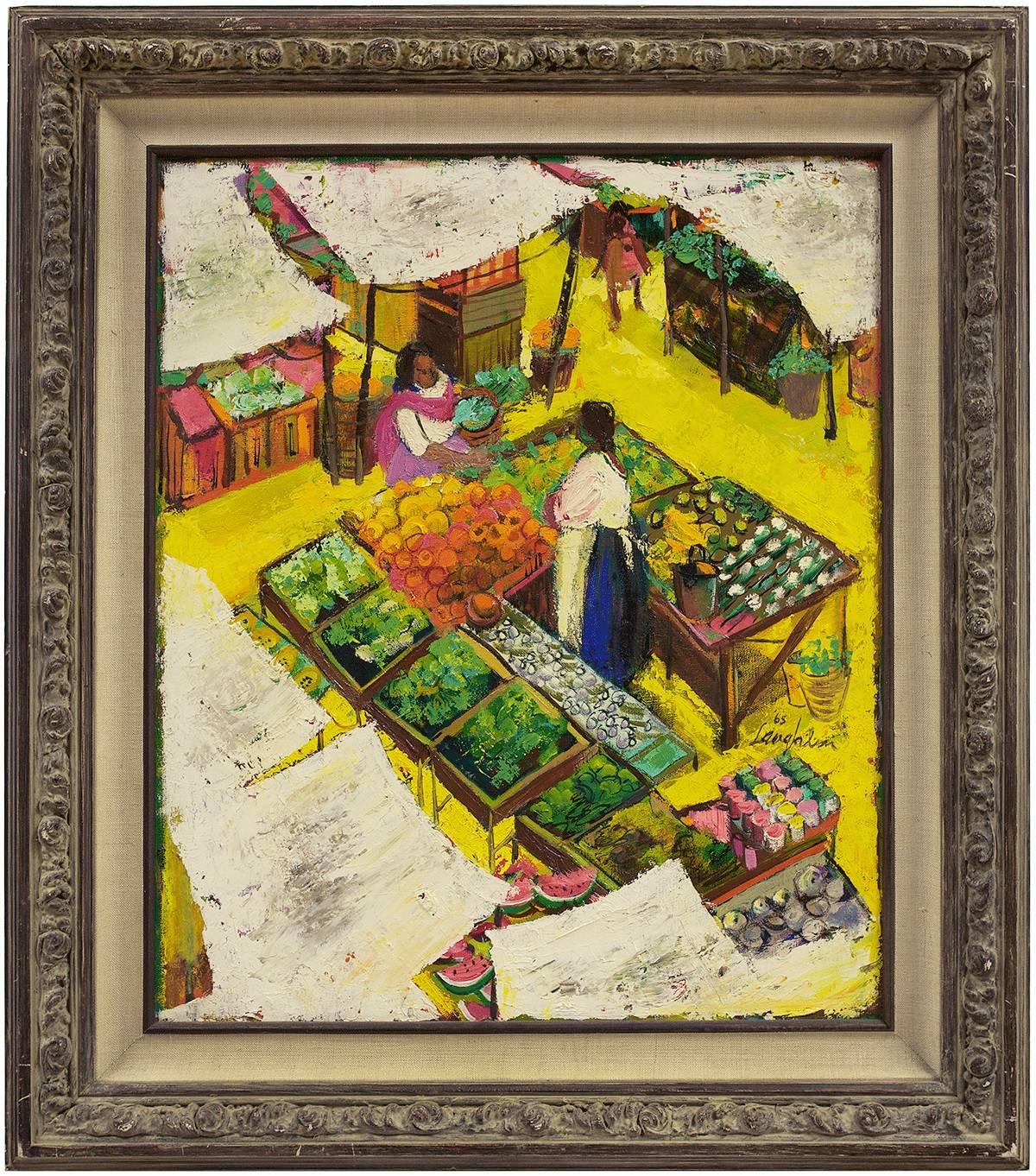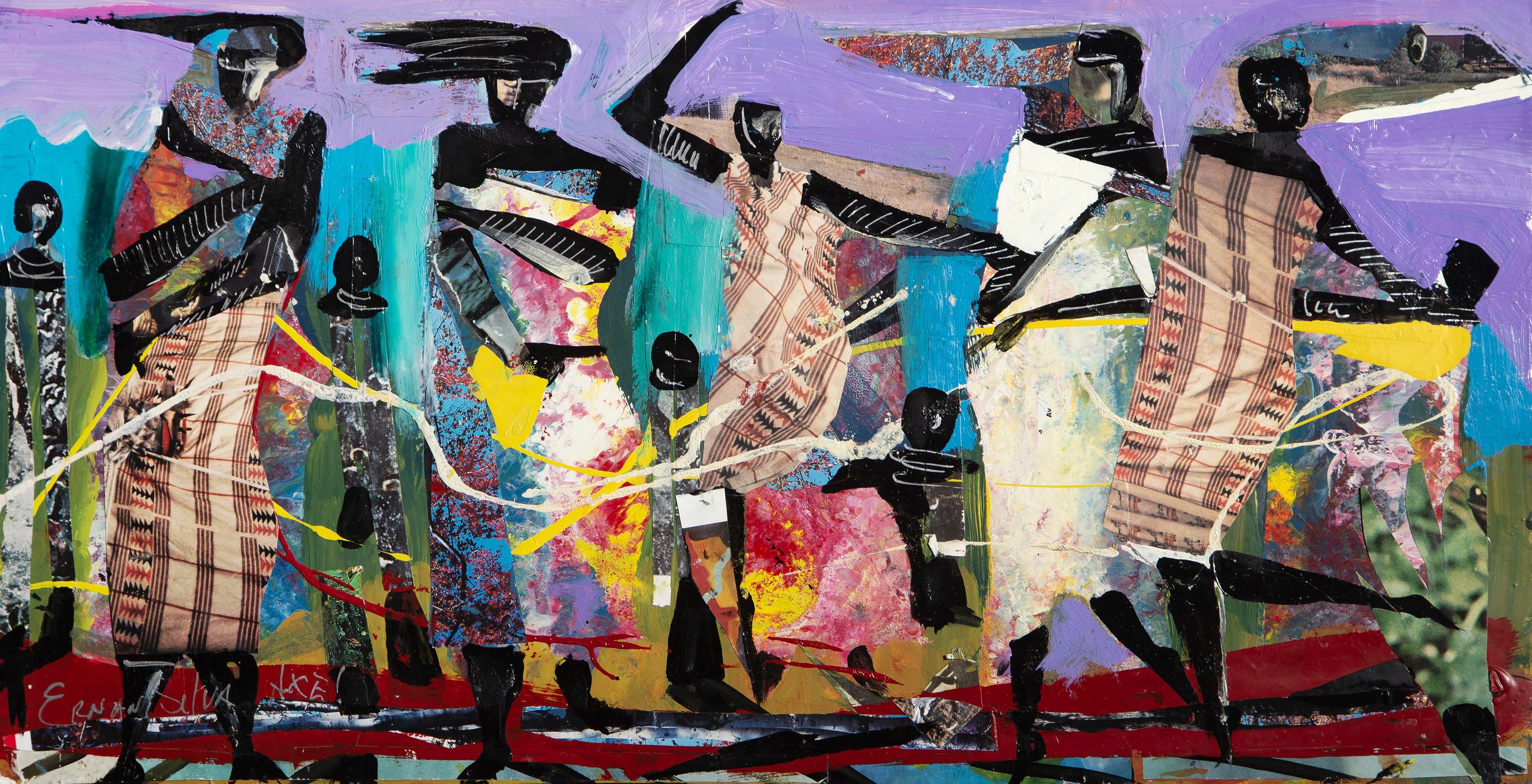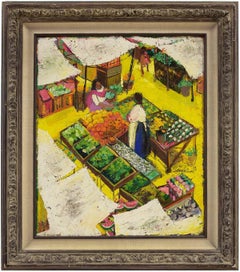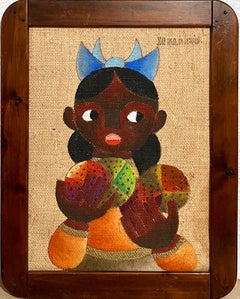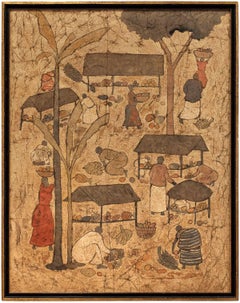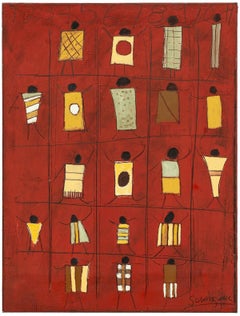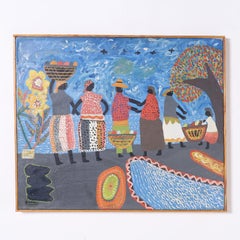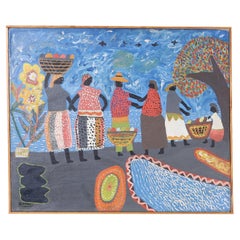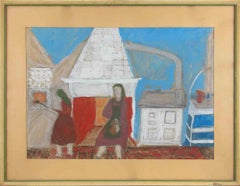Items Similar to Women with Baskets
Want more images or videos?
Request additional images or videos from the seller
1 of 6
UnknownWomen with Baskets
$450
£339.79
€394.23
CA$632.39
A$704.57
CHF 367.82
MX$8,554.46
NOK 4,623.26
SEK 4,370.11
DKK 2,942.87
About the Item
Gouache on newsprint Carribean Folk Art.
- Dimensions:Height: 14.75 in (37.47 cm)Width: 11.5 in (29.21 cm)
- Medium:
- Movement & Style:
- Period:
- Condition:Measurements include frame.
- Gallery Location:Surfside, FL
- Reference Number:1stDibs: LU38211955702
About the Seller
4.9
Platinum Seller
Premium sellers with a 4.7+ rating and 24-hour response times
Established in 1995
1stDibs seller since 2014
1,798 sales on 1stDibs
Typical response time: <1 hour
- ShippingRetrieving quote...Shipping from: Surfside, FL
- Return Policy
Authenticity Guarantee
In the unlikely event there’s an issue with an item’s authenticity, contact us within 1 year for a full refund. DetailsMoney-Back Guarantee
If your item is not as described, is damaged in transit, or does not arrive, contact us within 7 days for a full refund. Details24-Hour Cancellation
You have a 24-hour grace period in which to reconsider your purchase, with no questions asked.Vetted Professional Sellers
Our world-class sellers must adhere to strict standards for service and quality, maintaining the integrity of our listings.Price-Match Guarantee
If you find that a seller listed the same item for a lower price elsewhere, we’ll match it.Trusted Global Delivery
Our best-in-class carrier network provides specialized shipping options worldwide, including custom delivery.More From This Seller
View AllMarket Scene
Located in Surfside, FL
Vibrant market scene with vibrant impasto brushstrokes.
Category
Mid-20th Century Folk Art Figurative Paintings
Materials
Canvas, Oil
Folk Art Mexican Girl Oil Painting on Burlap Charming Naive African American Art
By Jose Maria de Servin
Located in Surfside, FL
Framed 29 X 23
Image 18 X 24
The sweetness that characterizes the work of Mexican painter Jose Maria de Servin (1917-83) is a melancholy and placid one. While he worked in the most modern of styles, he adapted it to an anecdotal folk-art approach distinctly his own.
When he was an infant, de Servin's family moved with him to Guadalajara. A city of history and culture, Guadalajara had a thriving artistic community with strong connections to Europe. His brothers Antonio and Miguel became artists as well, and in later years they worked collaboratively. As a teenager, de Servin studied at one of Mexico's Schools of Open-Air Painting, free art-teaching institutions sponsored by the government.
Later de Servin became a pupil of the painter Chucho Reyes, known for his improvisational watercolor variations on traditional Mexican themes. This interest in imagery particular to Mexico would be of great significance to de Servin. De Servin also studied under the more traditional painter Jose Vizcarra. In the early 1930s de Servin joined the Pintores Jovenes de Jalisco, or Young Painters of Jalisco.
An influence of critical importance to de Servin was Pablo Picasso. One of the originators of Cubism, the Spanish painter soon departed from its quasi-scientific and optical basis to create lively and humorous geometrical abstractions. It was this Cubism, personal and decorative, that de Servin adopted. His earliest Cubist works mimic Picasso, while during the second stage of his career, his works become smooth and polished, with an emphasis on gentle surface textures.
After these cautious years, however, a rough boldness enters along with dominating colors of earth and sand. Modernists like de Servin were interested in exploring what they considered primitive artmaking styles. The adoption of a native manner and native themes is in keeping with Modernist tenets, as is the use of nontraditional materials. De Servin's portraits of peasants, large-eyed and simply rendered, recall children's drawings. The rough burlap ground contrasts with the playful imagery and delicate range of color. The figures, all children or child-like adults, are all curves and simple shapes arranged harmoniously. De Servin's cubism is free from grotesquerie as it celebrates the simplicity of its subjects.
De Servin worked with the social-realist Jose Orozco on several large mural commissions in Guadalajara, including one at the Legislative Palace. While their styles were dissimilar, both made use of Mexican imagery to glorify the common people. A sought-after muralist in his own right, de Servin brought the rich colors and endearing characters of his panels to his larger-scale work.
For 15 years, de Servin taught summer art classes at the University of Arizona. His career was marked by many one-man shows, both in North America and Europe. In recent years, his striking style has attracted increased notice from critics and the public.
His style is a unique conglomerate of tradition, history, legends, heroes, old customs and folklore. It is a self-standing style, recognizable, cheerful, whimsical and a happy creation. Naïve art is any form of visual art that is created by a person who lacks the formal education and training that a professional artist undergoes (in anatomy, art history, technique, perspective, ways of seeing). Unlike folk art, naïve art does not necessarily evince a distinct cultural context or tradition. Naïve art is recognized, and often imitated, for its childlike simplicity and frankness. Paintings of this kind typically have a flat rendering style with a rudimentary expression of perspective.
One particularly influential painter of "naïve art" was Henri Rousseau (1844–1910), a French Post-Impressionist who was discovered by Pablo Picasso. Naïve art is often seen as outsider art that is by someone without formal (or little) training or degree. While this was true before the twentieth century, there are now academies for naïve art. Naïve art is now a fully recognized art genre, represented in art galleries worldwide.
Museums devoted to naïve art now exist in Kecskemét, Hungary; Riga, Latvia; Jaen, Spain; Rio de Janeiro, Brasil; Vicq France and Paris. "Primitive art" is another term often applied to art by those without formal training, but is historically more often applied to work from certain cultures that have been judged socially or technologically "primitive" by Western academia, such as Native American, sub saharan African or Pacific Island art (see Tribal art). This is distinguished from the self-conscious, "primitive" inspired movement primitivism. Another term related to (but not completely synonymous with) naïve art is folk art. There also exist the terms "naïvism" and "primitivism" which are usually applied to professional painters working in the style of naïve art (like Paul Gauguin, Mikhail Larionov, Paul Klee).
At all events, naive art can be regarded as having occupied an "official" position in the annals of twentieth-century art since - at the very latest - the publication of the Der Blaue Reiter, an almanac in 1912. Wassily Kandinsky and Franz Marc, who brought out the almanac, presented 6 reproductions of paintings by le Douanier' Rousseau (Henri Rousseau), comparing them with other pictorial examples. However, most experts agree that the year that naive art was "discovered" was 1885, when the painter Paul Signac became aware of the talents of Henri Rousseau and set about organizing exhibitions of his work in a number of prestigious galleries. The Earth Group (Grupa Zemlja) were Croatian artists, architects and intellectuals active in Zagreb from 1929 to 1935. The group included the painters Krsto Hegedušić, Edo Kovačević, Omer Mujadžić, Kamilo Ružička, Ivan Tabaković, and Oton Postružnik, the sculptors Antun Augustinčić, Frano Kršinić, and the architect Drago Ibler. A term applied to Yugoslav (Croatian) naive painters working in or around the village of Hlebine, near the Hungarian border, from about 1930. Some of the best known naive artists are Dragan Gaži, Ivan Generalić, Josip Generalić, Krsto Hegedušić, Mijo Kovačić, Ivan Lacković-Croata, Franjo Mraz, Ivan Večenaj and Mirko Virius. Camille Bombois (1883–1970) Ferdinand Cheval, known as 'le facteur Cheval' (1836–1924) Henry Darger (1892–1973) L. S. Lowry (1887–1976) Grandma Moses, Anna Mary Robertson (1860–1961) Nikifor (1895–1968) Poland, Horace Pippin (1888–1946) Jon Serl (1894-1993) United States Alfred Wallis (1855–1942) Scottie Wilson (1890–1972) Gesner Abelard...
Category
Mid-20th Century Folk Art Figurative Paintings
Materials
Burlap, Oil
Asian Market Mixed Media Painting
Located in Surfside, FL
This is a South Asian or Indonesian Painting of an outdoor fresh market. on a textured background.
A lovely piece.
Category
Mid-20th Century Figurative Paintings
Materials
Mixed Media
Twenty Figures
By Mary Scrimgeour
Located in Surfside, FL
A market in the South of France, a remote island in the Gulf of Mexico and a desert sojourn are all part of a newly defined narrative for artist Mary Scrimgeour. Recently as a result of taking a self-imposed sabbatical from painting full time in a quest for redefinition of her painting career she has spent the last three years traveling, writing and studying art in pursuit of a deeper perhaps more authentic level of her creativity. Embracing a minimalist philosophy she chose to sell everything that she owned except for a few necessary things and set out in search of a new perspective and new experiences. These new experiences have led her to a refreshed and reinvigorated new approach to her work that has evolved into designing and writing illustrated books as well as painting.
Mary Scrimgeour studied art at the University of Colorado in Boulder. She paints whimsical pictures of her favorite things such as ice cream cones, tools and aircraft. Scrimgeour adds layers of information about the creative process and invention to each of the paintings.
Mary is a self-taught artist whose work is collected nationally as well as internationally.
Selected Collections:
Long Beach Museum of Modern Art, Long Beach, CA
Jon Stewart’s “The Daily Show,” Denver office,
Children’s Hospital, Denver, CO,
Armstrong Oil and...
Category
Late 20th Century Contemporary Abstract Paintings
Materials
Canvas, Oil
Folk Art Mexican Boy Oil Painting on Burlap Charming Naive African American Art
By Jose Maria de Servin
Located in Surfside, FL
Framed 29 X 23
Image 18 X 24
The sweetness that characterizes the work of Mexican painter Jose Maria de Servin (1917-83) is a melancholy and placid one. While he worked in the most modern of styles, he adapted it to an anecdotal folk-art approach distinctly his own.
When he was an infant, de Servin's family moved with him to Guadalajara. A city of history and culture, Guadalajara had a thriving artistic community with strong connections to Europe. His brothers Antonio and Miguel became artists as well, and in later years they worked collaboratively. As a teenager, de Servin studied at one of Mexico's Schools of Open-Air Painting, free art-teaching institutions sponsored by the government.
Later de Servin became a pupil of the painter Chucho Reyes, known for his improvisational watercolor variations on traditional Mexican themes. This interest in imagery particular to Mexico would be of great significance to de Servin. De Servin also studied under the more traditional painter Jose Vizcarra. In the early 1930s de Servin joined the Pintores Jovenes de Jalisco, or Young Painters of Jalisco.
An influence of critical importance to de Servin was Pablo Picasso. One of the originators of Cubism, the Spanish painter soon departed from its quasi-scientific and optical basis to create lively and humorous geometrical abstractions. It was this Cubism, personal and decorative, that de Servin adopted. His earliest Cubist works mimic Picasso, while during the second stage of his career, his works become smooth and polished, with an emphasis on gentle surface textures.
After these cautious years, however, a rough boldness enters along with dominating colors of earth and sand. Modernists like de Servin were interested in exploring what they considered primitive artmaking styles. The adoption of a native manner and native themes is in keeping with Modernist tenets, as is the use of nontraditional materials. De Servin's portraits of peasants, large-eyed and simply rendered, recall children's drawings. The rough burlap ground contrasts with the playful imagery and delicate range of color. The figures, all children or child-like adults, are all curves and simple shapes arranged harmoniously. De Servin's cubism is free from grotesquerie as it celebrates the simplicity of its subjects.
De Servin worked with the social-realist Jose Orozco on several large mural commissions in Guadalajara, including one at the Legislative Palace. While their styles were dissimilar, both made use of Mexican imagery to glorify the common people. A sought-after muralist in his own right, de Servin brought the rich colors and endearing characters of his panels to his larger-scale work.
For 15 years, de Servin taught summer art classes at the University of Arizona. His career was marked by many one-man shows, both in North America and Europe. In recent years, his striking style has attracted increased notice from critics and the public.
His style is a unique conglomerate of tradition, history, legends, heroes, old customs and folklore. It is a self-standing style, recognizable, cheerful, whimsical and a happy creation. Naïve art is any form of visual art that is created by a person who lacks the formal education and training that a professional artist undergoes (in anatomy, art history, technique, perspective, ways of seeing). Unlike folk art, naïve art does not necessarily evince a distinct cultural context or tradition. Naïve art is recognized, and often imitated, for its childlike simplicity and frankness. Paintings of this kind typically have a flat rendering style with a rudimentary expression of perspective.
One particularly influential painter of "naïve art" was Henri Rousseau (1844–1910), a French Post-Impressionist who was discovered by Pablo Picasso. Naïve art is often seen as outsider art that is by someone without formal (or little) training or degree. While this was true before the twentieth century, there are now academies for naïve art. Naïve art is now a fully recognized art genre, represented in art galleries worldwide.
Museums devoted to naïve art now exist in Kecskemét, Hungary; Riga, Latvia; Jaen, Spain; Rio de Janeiro, Brasil; Vicq France and Paris. "Primitive art" is another term often applied to art by those without formal training, but is historically more often applied to work from certain cultures that have been judged socially or technologically "primitive" by Western academia, such as Native American, sub saharan African or Pacific Island art (see Tribal art). This is distinguished from the self-conscious, "primitive" inspired movement primitivism. Another term related to (but not completely synonymous with) naïve art is folk art. There also exist the terms "naïvism" and "primitivism" which are usually applied to professional painters working in the style of naïve art (like Paul Gauguin, Mikhail Larionov, Paul Klee).
At all events, naive art can be regarded as having occupied an "official" position in the annals of twentieth-century art since - at the very latest - the publication of the Der Blaue Reiter, an almanac in 1912. Wassily Kandinsky and Franz Marc, who brought out the almanac, presented 6 reproductions of paintings by le Douanier' Rousseau (Henri Rousseau), comparing them with other pictorial examples. However, most experts agree that the year that naive art was "discovered" was 1885, when the painter Paul Signac became aware of the talents of Henri Rousseau and set about organizing exhibitions of his work in a number of prestigious galleries. The Earth Group (Grupa Zemlja) were Croatian artists, architects and intellectuals active in Zagreb from 1929 to 1935. The group included the painters Krsto Hegedušić, Edo Kovačević, Omer Mujadžić, Kamilo Ružička, Ivan Tabaković, and Oton Postružnik, the sculptors Antun Augustinčić, Frano Kršinić, and the architect Drago Ibler. A term applied to Yugoslav (Croatian) naive painters working in or around the village of Hlebine, near the Hungarian border, from about 1930. Some of the best known naive artists are Dragan Gaži, Ivan Generalić, Josip Generalić, Krsto Hegedušić, Mijo Kovačić, Ivan Lacković-Croata, Franjo Mraz, Ivan Večenaj and Mirko Virius. Camille Bombois (1883–1970) Ferdinand Cheval, known as 'le facteur Cheval' (1836–1924) Henry Darger (1892–1973) L. S. Lowry (1887–1976) Grandma Moses, Anna Mary Robertson (1860–1961) Nikifor (1895–1968) Poland, Horace Pippin (1888–1946) Jon Serl (1894-1993) United States Alfred Wallis (1855–1942) Scottie Wilson (1890–1972) Gesner Abelard...
Category
Mid-20th Century Folk Art Figurative Paintings
Materials
Burlap, Oil
Original Graphic Hungarian Illustration Art Emma Heinzelmann Children's Book Art
Located in Surfside, FL
Original vintage gouache painting on poster board by Emma Heinzelmann (Hungarian, born 1930). Hungarian Peasant art, children fairytale themes, in psychedelic pop colors of the era. This framed painting depicts figures, a rooster and angels in flying above. Artist signature on farm gate. Housed in chrome mid century frame.
Framed: 19.5 X 25.5 image is 15 X 21.
Emma Heinzelmann ( Nyírbátor , March 14 , 1930 - ) Munkácsy Prize-winning Hungarian graphic designer and illustrator.
Heinzelmann is a Hungarian children's book illustrator and graphic poster artist, who started her career during the 1950’s. She has a very unique drawing style that resembles children’s book illustrations. Working in psychedelic pop colors of the era. She Initially she studied to be a costume designer but she soon turned to graphic design. She graduated in 1950 from the clothing design department at the Junior High School in Török Pál Street which operated under the name Szépmíves Lyceum from 1946 to 1950. His master was György Farkas, a ceramicist, painter and sculptor. She creates her compositions using mainly watercolor and gouache paint. She often worked on illustrations for children’s books, since her style fits their themes. Her posters show the same playful Hungarian Folk Art style. She has produced artwork in almost all areas of applied graphics. posters, commemorative cards, designed album covers, postcards, advertising graphics, slide films, animation and cartoons. Her drawings were published in Dörmögő Dömötör and Kisdobos among others as well as in children's magazines. An entire generation of children grew up with her book illustrations, reading the fairy tales of Wilhelm Hauff or Hans Christian Andersen. Her story books and drawings are known well beyond our borders. She illustrated nearly 80 storybooks. She is a contemporary of Maurice Sendak and William Steig. Her work is of the same genre as the iconic Polish Cyrk poster artists.
In her original fine art graphics grotesque and bitter elements often prevail, her figures are playfully ironic. Her drawings are made in a variety of ways, from pencil drawings to watercolor painting to collage techniques, from decorative spot effects to lace-like line drawings. She is no stranger to a kind of Art Nouveau influence, but it is always individual. It was never beautiful, but over the years its color scheme changed, thus confirming the lines of József Somogyi quoted earlier. She had several individual exhibitions, and for more than 10 years as a member of the Papp-Gábor group, her works could be seen in Dorottya Street.
In 2009 , the book of art historian András Székely was published by Holnap Könyvkiadó under the title Emma Heinzelmann: fairy tales in the drawing.
Awards and recognitions
Lot Prize (International Poster Biennale, Warsaw) (1972)
Ministry of Culture Award (1977, 1979)
Brno Graphic Biennale (Bronze Award) (1980)
Worker's Award (1984)
Children's Book of the Year Award (1984)
IBBY Andersen Diploma (1988)
Hamburg Lifetime Achievement Award (1990)
Albert Star Award (1992)
Noémi Ferenczy Award (2005)
Munkácsy Award (1984)
Solo Exhibitions:
Thought Bookstore, Budapest (1965)
Cultural Center, Nyíregyháza (1974)
Little Gallery, Komárom (1982)
Art Gallery, Budapest. (1990)
Vác (2010)
Selected group exhibitions:
International Children's Book Fair and Exhibition, Bologna (1971-1975)
International Graphic Biennale, Brno (1966-1985)
BIB (Children's book illustration biennial), Bratislava (1970-1985)
XXXVI. Venice Biennale, Venice (1972)
ARC. International Poster Biennale, Warsaw (1972)
International Poster Triennale (B) (1972-1974)
Weekdays, graphic exhibition, (1975)
Calligraphy and typography, Institute of Cultural Relations, Budapest (1977)
"Falrahányt pea", graphic exhibition, Institute of Cultural Relations, Budapest.(1978)
International Poster Triennale (B) (1978)
National Poster Exhibitions, Art Gallery, Budapest (1978)(1980)
International Poster Exhibition (IR) (1979)
Slide films:
Fairy tales with Emma Heinzelmann's drawings:
Under the Shore (1981)
Goose Party (1981)
Take a Little Trumpet (1982)
The Bremen Town...
Category
Mid-20th Century Folk Art Figurative Paintings
Materials
Gouache
You May Also Like
Folk Art Tropical Painting on Canvas
Located in Palm Beach, FL
Charming acrylic painting on canvas of a group of colorful figures in a tropical setting executed in a naive style. Signed Osnel in the lower right and presented in the original wood...
Category
20th Century Folk Art Figurative Paintings
Materials
Acrylic
Folk Art Tropical Painting on Canvas
Located in Palm Beach, FL
Charming acrylic painting on canvas of a group of colorful figures in a tropical setting executed in a naive style. Signed Osnel in the lower right and presented in the original wood...
Category
20th Century Caribbean Folk Art Paintings
Materials
Paint
Women - Mixed media - Mid-20th Century
Located in Roma, IT
Women is a contemporary artwork realized by Artist of the mid-20th century
Mixed media
Includes frame
Category
Mid-20th Century Modern Interior Paintings
Materials
Mixed Media
Women with Flowers, Folk Art Acrylic Painting by Ernani Silva
Located in Long Island City, NY
Ernani Silva, Brazilian - Women with Flowers, Medium: Acrylic, Collage and Enamel on board, signed in marker, Size: 9.25 x 27.5 in. (23.5 x 69.85 cm)
Category
1990s Folk Art Figurative Paintings
Materials
Enamel
Women and Children, Folk Art Acrylic Painting by Ernani Silva
Located in Long Island City, NY
Ernani Silva, Brazilian - Women and Children, Medium: Acrylic, Collage and Enamel on board, signed in marker, Size: 11.25 x 22 in. (28.58 x 55.88 cm)
Category
1990s Folk Art Figurative Paintings
Materials
Enamel
Mid-Century Modern Expressive Figurative Framed Oil Painting - Basket Carriers
Located in Bristol, GB
BASKET CARRIERS
Oil on Canvas
Size: 74 x 43.5 cm (including frame)
A wonderful mid century modernist composition, painted in oil onto canvas.
Two figures with baskets on their head...
Category
1960s Modern Figurative Paintings
Materials
Oil, Canvas
More Ways To Browse
Box Car
Battle Scene Paintings
Spanish Village
Man And Dog
Indian Mother
Chagall Oil Paintings
Painting The Bathers
Dutch Oil Paintings 17th Century
Boy London
Naive Art France
Jacobs Oil Paintings
Cartoon Oil Paintings
Paintings Signed Eric
Spanish Painting Saint
Disney Original Art
Human Feet
Judaica Paintings
Russian Dancers
